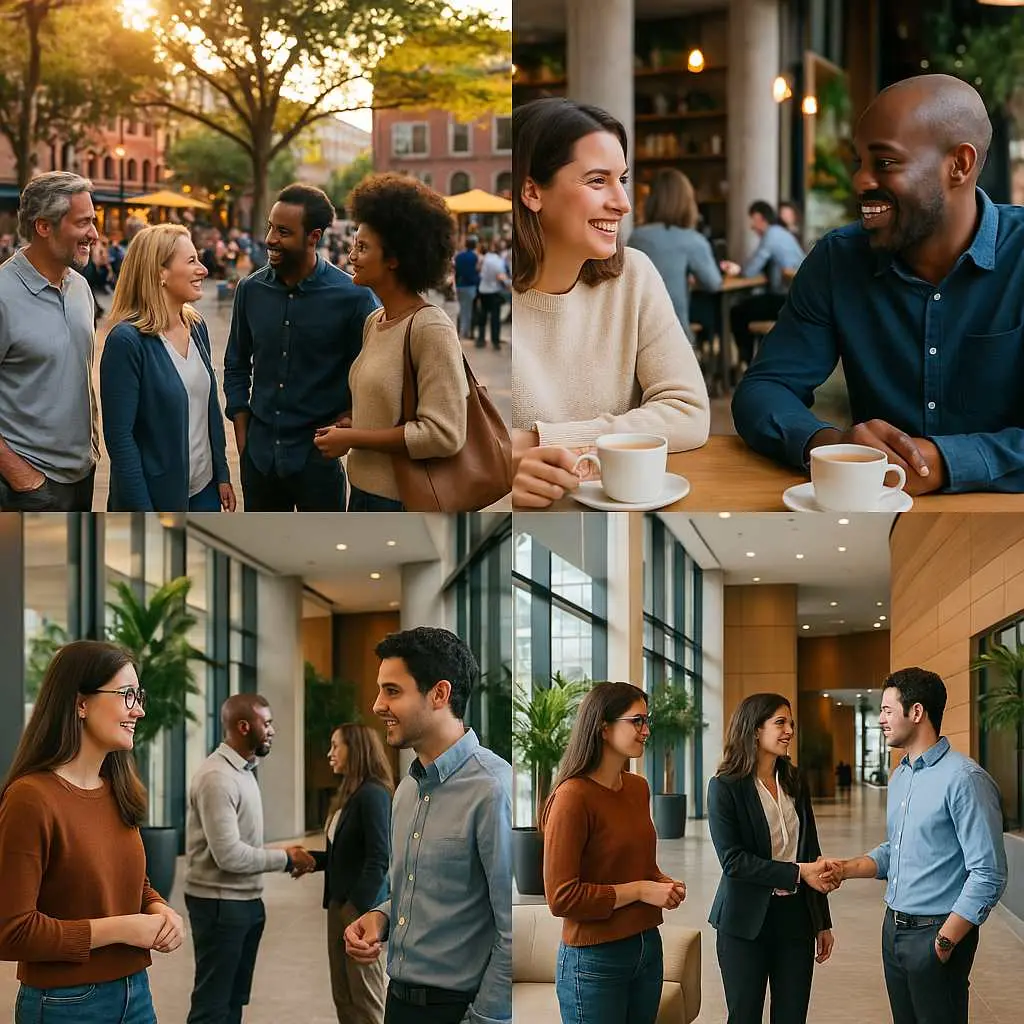As an advocate for organic spatial interactions, I’ve seen the magic in unscripted social encounters. At Curvspace, our designs foster environments where spontaneous design creates magical spaces where unplanned encounters thrive. This article reveals the charm of unscripted socials and how nurturing these organic interactions through thoughtful attention to elements like transitional spaces can enrich community dynamics and foster a more connected human experience. We believe in dynamic social design that allows life to unfold naturally within the structures we create.
Jump to:
The Allure of the Unscripted: Why We Crave Spontaneity
In our increasingly scheduled and digitally mediated lives, there’s a profound, almost primal craving for the unexpected, the serendipitous moment that breaks the monotony. Think about it – when was the last time a perfectly planned meeting yielded the same jolt of delight as bumping into an old friend unexpectedly, or striking up a conversation with a stranger that led to a surprising insight? These unscripted socials hold a unique power. They feel authentic, born from the moment rather than obligation. This isn’t just nostalgia for a less structured time; it taps into a fundamental aspect of human nature.
There’s a concept in social science and economics called “spontaneous order,” which describes systems that emerge naturally from the voluntary actions of individuals, rather than being meticulously planned from the top down. Think of a bustling marketplace or the pathways naturally worn into a grassy field – these patterns arise organically. I believe the most vibrant social environments exhibit a similar quality. While completely unplanned spaces can descend into chaos, spaces that allow for spontaneity, that provide the right conditions for organic interactions without forcing them, feel alive. They possess a certain magic. This magic stems from possibility – the possibility of connection, discovery, and shared experience that wasn’t on the agenda. It’s the thrill of the unknown intersecting with our daily routines. These unplanned encounters remind us that life isn’t just a series of checkboxes, but a fluid, dynamic process full of potential connections waiting to happen. Why wouldn’t we want the spaces we inhabit daily – our homes, workplaces, and public squares – to reflect and encourage this vital aspect of human existence? At Curvspace, we see designing for this potential not as an afterthought, but as a core principle.
Designing for Serendipity: Principles of Spontaneous Design
So, how do we move from appreciating unscripted socials to actively fostering them through design? This is where the philosophy of spontaneous design comes in. It’s not about relinquishing control entirely, but about shifting the focus from dictating specific activities to creating environments rich with potential for interaction. It requires a delicate balance, understanding human psychology, movement, and the subtle cues that make a space feel inviting and conducive to lingering, pausing, and perhaps, connecting. It means challenging the purely functional approach that treats spaces merely as containers for predetermined tasks.
Embracing Organic Flow
Think about how people naturally move through a space. Often, the most direct, efficient path isn’t the one that encourages interaction. Spontaneous design looks at circulation not just as getting from A to B, but as an opportunity. How can pathways encourage pausing? Can sightlines offer intriguing glimpses into other areas, sparking curiosity? This involves designing with an understanding of natural human tendencies, sometimes even embracing the “desire paths” – those unofficial trails people create – as indicators of intuitive flow. It also involves blurring the lines between distinct zones. Instead of hard divisions, using subtle shifts in materials, lighting, or ceiling height can delineate areas while maintaining a sense of openness and connection, making transitions less abrupt and more inviting for casual pauses.
The Power of ‘In-Between’ – Transitional Spaces
Often overlooked, transitional spaces – corridors, stairwells, lobbies, landings, thresholds – are critical arenas for unplanned encounters. We spend a surprising amount of time moving between destinations. Spontaneous design elevates these areas from mere conduits to potential social catalysts. Psychologically, these spaces prepare us for what’s next; crossing a threshold is a mental recalibration. By making these transitions more engaging, we increase the likelihood of interaction.
Imagine a wide staircase landing with built-in seating and a view, or a corridor featuring rotating art installations. These aren’t just passageways anymore; they become destinations in their own right, places to pause, reflect, and potentially connect with others doing the same. Materiality plays a huge role here – swapping cold, sterile finishes for warmer, tactile materials like timber or textured stone can make a corridor feel less like a tunnel and more like a room. Strategic lighting can create inviting pools of light, and windows offering views of nature or other active areas can draw people in. At Curvspace, we pay close attention to the sensory experience within these transitional spaces, using light, sound, and even temperature to make them comfortable and appealing zones for pausing. These aren’t dead zones; they are zones of potential.
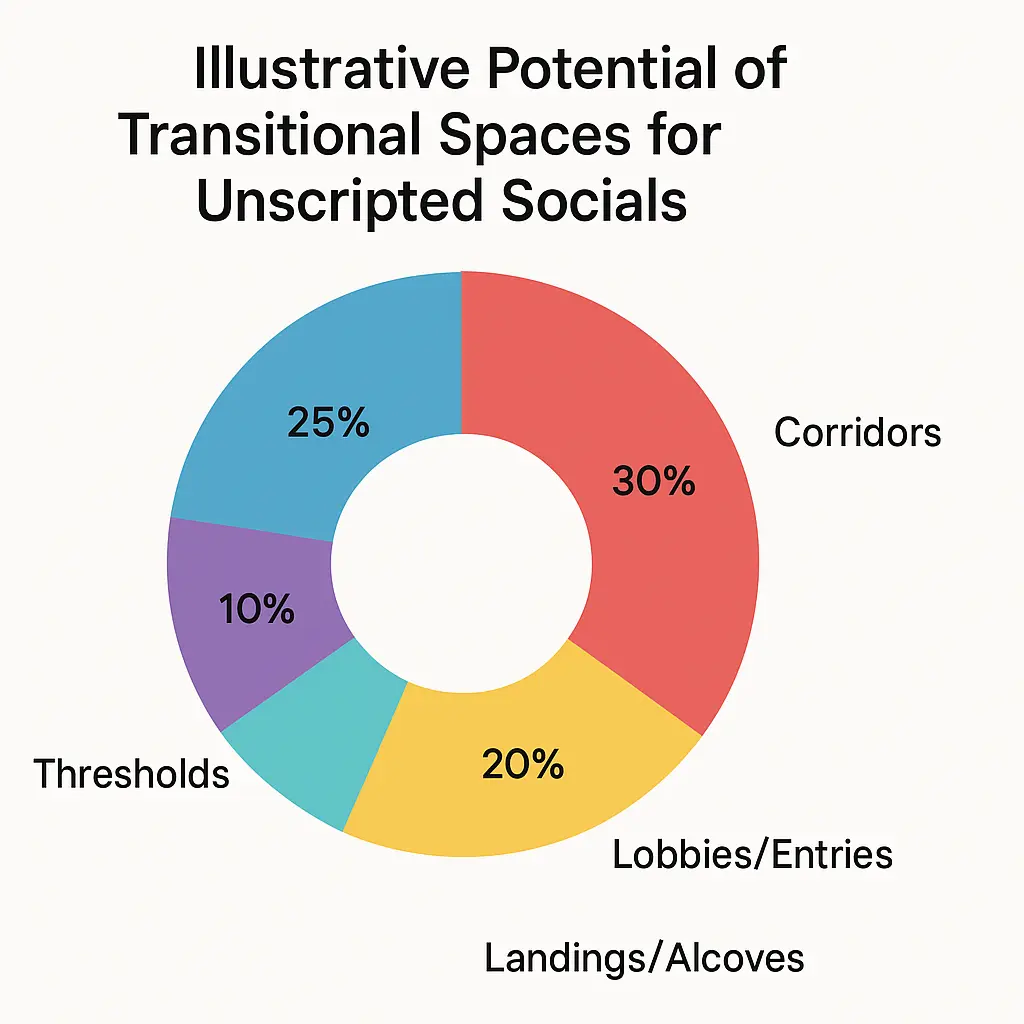
Flexible and Unprogrammed Zones
Not every square foot needs a designated purpose. In fact, some of the most socially generative spaces are those left deliberately undefined. Think of a large landing that can host an impromptu meeting, a quiet alcove perfect for a phone call that might lead to a brief chat with a passerby, or lobby furniture easily rearranged for different group sizes. Spontaneous design incorporates these “unprogrammed” or “loosely programmed” zones. They provide breathing room in the spatial narrative, offering users agency to adapt the space to their immediate needs. This flexibility is key; it allows for organic interactions to emerge based on circumstance rather than prescription. It acknowledges that human needs and interactions are fluid and provides the physical substrate to support that fluidity. These spaces become stage sets waiting for the actors – the users – to bring them to life in ways the designer might not have even anticipated.
Integrating Nature’s Randomness (Biophilia)
There’s a powerful connection between nature and well-being, and this extends to social interaction. Biophilic design – incorporating natural elements like plants, water, natural light, and materials like wood and stone – does more than just beautify a space. Nature itself is inherently dynamic and subtly unpredictable. Incorporating it into our built environments can make them feel calmer, more restorative, and paradoxically, more alive. Living walls, indoor gardens, or even simple potted plants can soften hard edges, improve air quality, and create pockets of tranquility that invite people to pause. Views of nature from within transitional spaces or communal areas can reduce stress and make people more receptive to casual conversation. The use of natural materials adds warmth and texture, making spaces more tactile and inviting. By bringing elements of the natural world indoors, we tap into an innate human affinity for nature, creating environments where people feel more comfortable, relaxed, and open to the possibility of unplanned encounters.
Curvspace in Action: Cultivating Organic Interactions
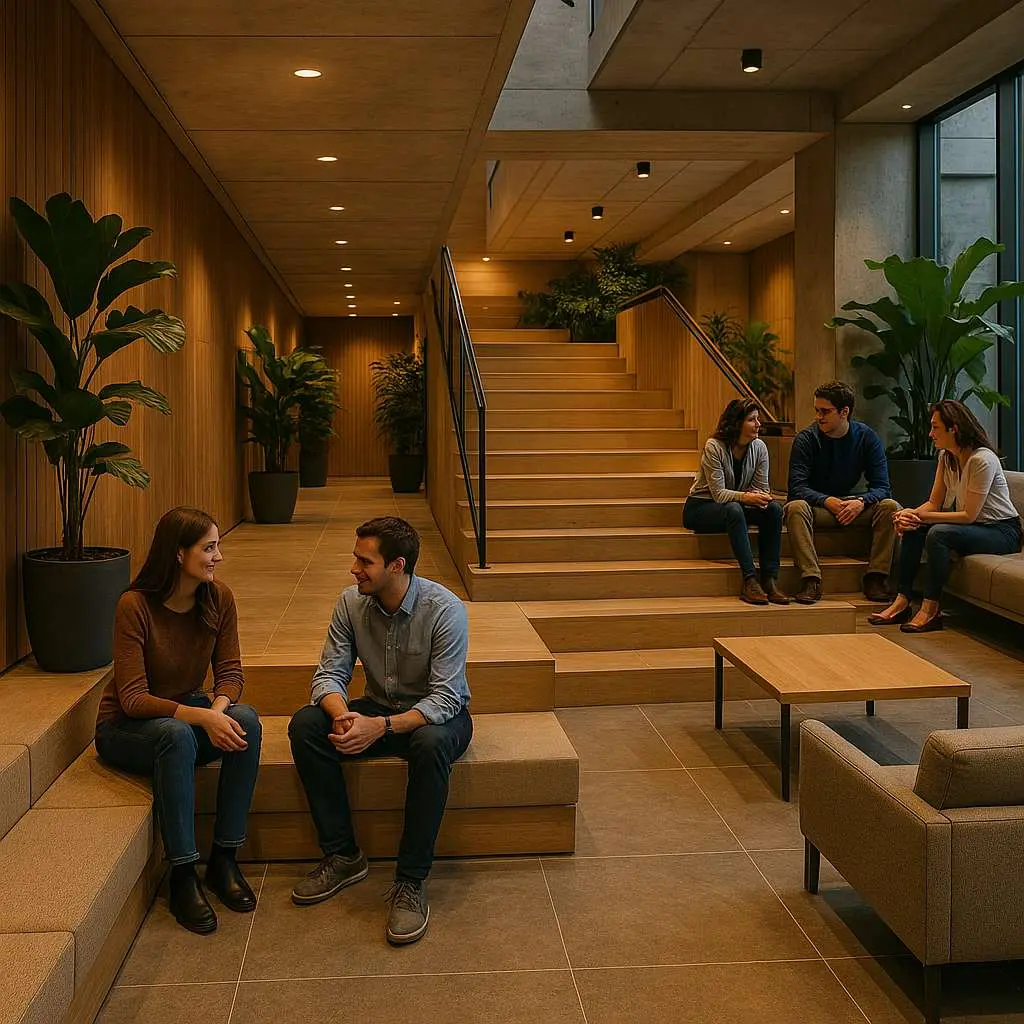
At Curvspace, these principles aren’t just theoretical; they are foundational to our design process. We actively seek ways to weave the potential for unscripted socials into the fabric of the spaces we shape. It’s about designing with human nature, not against it. Our goal is to create environments that feel intuitive, comfortable, and subtly encourage those magical spaces where connections happen naturally.
We pay particular attention to those crucial transitional spaces. Instead of treating a corridor as just a path, we might widen it slightly, incorporate seating niches, use warm, natural materials, and employ lighting strategies that create a welcoming ambiance rather than a purely functional illumination. Stairwells can become sculptural elements that invite exploration, with landings designed as mini-lounges offering views or moments of pause. We consider the sensory experience paramount – how does the light change as you move through the space? Is there acoustic baffling to allow for quiet conversation without disturbance? Can temperature variations create cozy corners? These details transform transitions into opportunities.
Material selection is deliberate. We favor materials that feel good to the touch, that age gracefully, and that contribute to a sense of warmth and welcome. Think textured wood, natural stone, soft textiles – elements that invite lingering rather than rushing through. Biophilic elements are integrated not just as decoration, but as integral parts of the spatial experience, bringing life and tranquility into common areas and pathways.
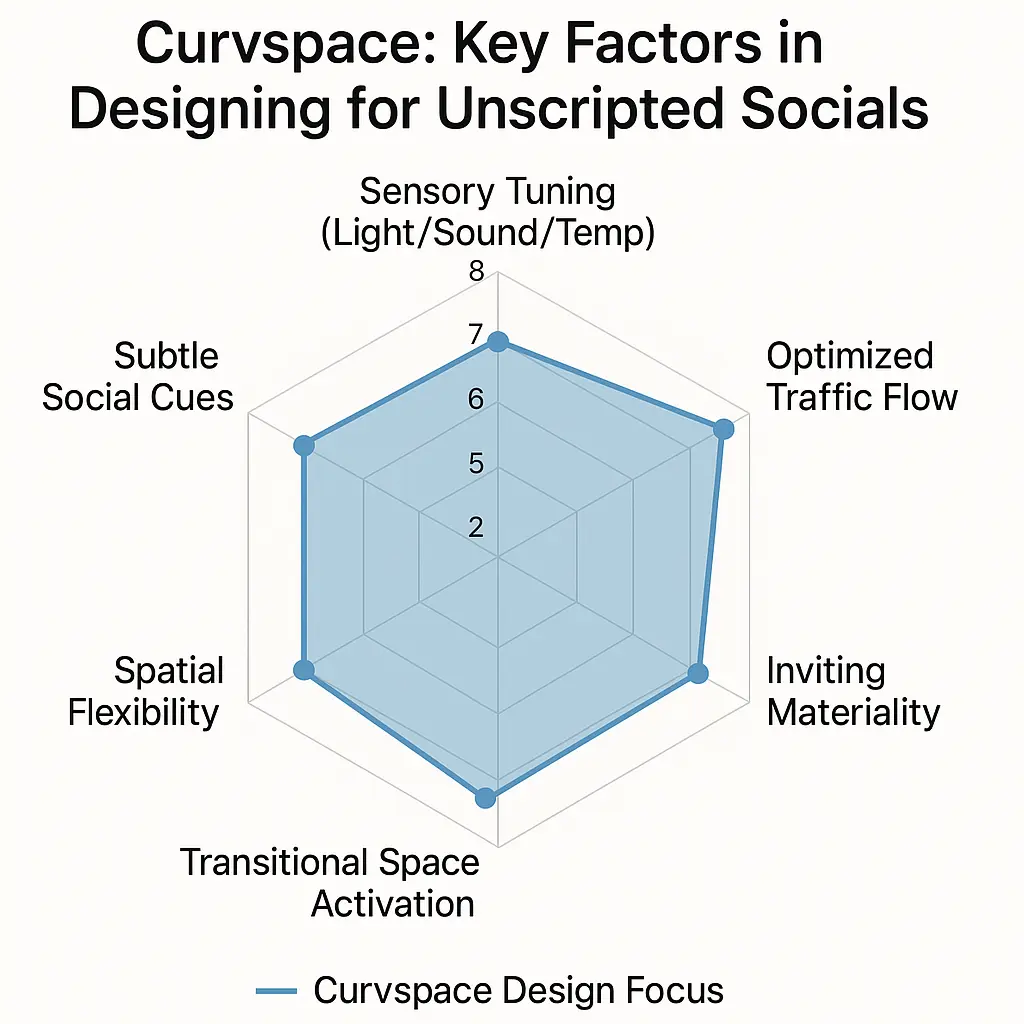
The Social Fabric: How Unscripted Encounters Build Community
Why does all this matter? Because these seemingly small, unplanned encounters are the threads that weave the social fabric of a community. They build what sociologists call “social capital” – the networks of relationships among people who live and work in a particular society, enabling that society to function effectively. Unscripted socials are particularly good at fostering “weak ties,” those casual acquaintanceships outside our close circle of friends and family. Research shows these weak ties are often crucial for finding new opportunities, information, and perspectives precisely because they connect us to different social circles.
Think about an office building designed with inviting transitional spaces and comfortable communal hubs. Chance conversations by the coffee machine or on a shared landing can break down departmental silos, leading to cross-pollination of ideas and unexpected collaborations. This is how innovation often sparks – not in formal meetings, but in casual exchanges where different viewpoints collide [8 – metaphorically speaking]. Similarly, in a residential building, bumping into neighbors in a well-designed lobby or shared courtyard fosters a sense of familiarity and belonging. These small interactions make a place feel less anonymous and more like a genuine community.
The great urbanist Jane Jacobs championed the idea that the vitality and beauty of a city emerge not from rigid master plans, but from the complex, spontaneous interactions of its inhabitants. She wrote about the “ballet of the good city sidewalk,” a constantly improvising dance of brief encounters and public life.
“Cities have the capability of providing something for everybody, only because, and only when, they are created by everybody.” – Jane Jacobs
While she focused on the urban scale, the principle applies within buildings too. Designing spaces that allow for this “ballet” – for organic interactions and spontaneous design – creates environments that are not just functional, but truly alive. These encounters contribute significantly to our overall well-being, reducing feelings of isolation and reinforcing our sense of being part of something larger than ourselves. It’s about creating magical spaces where community isn’t just housed, but actively nurtured.
Challenges and Considerations in Spontaneous Design
Of course, designing for spontaneity isn’t without its challenges. It requires navigating a careful balance. One key consideration is privacy. While the goal is to encourage interaction, spaces must also offer opportunities for retreat and solitude. An environment that feels constantly “on” can be draining. Spontaneous design should create opportunities for connection, not obligations. This means providing a variety of spatial experiences, from open, active zones to quieter, more secluded niches.
Safety and security are also paramount, especially in more open, fluid designs. Clear sightlines, appropriate lighting, and intuitive wayfinding are essential to ensure people feel comfortable and secure as they navigate these spaces. The design should feel welcoming and accessible to everyone, regardless of age or ability.
There’s also the risk of trying too hard, of creating spaces that feel artificial or forced in their attempts to engineer interaction. Authenticity is key. The design should feel natural and supportive, arising from an understanding of the context and the potential users, rather than imposing a specific social agenda. The best spontaneous design often feels almost invisible – it simply works, allowing social life to unfold organically.
Measuring the success of such designs can also be tricky. Unlike measuring the efficiency of a workflow, the benefits of unscripted socials are often qualitative and experiential. While analytical tools like Space Syntax or concepts like the Coefficient of Unplanned Encounter (CUE) attempt to quantify interaction potential based on layout and circulation, the true measure lies in the feeling of the space and the quality of life it supports. Does it feel vibrant? Do people linger? Is there a sense of community?
Finally, cultural context matters. Norms around personal space, privacy, and social interaction vary significantly. A design that works well in one cultural setting might feel intrusive or uncomfortable in another. Effective spontaneous design requires sensitivity to these nuances, tailoring the approach to the specific user group and location.
Looking Ahead: The Future is Fluid
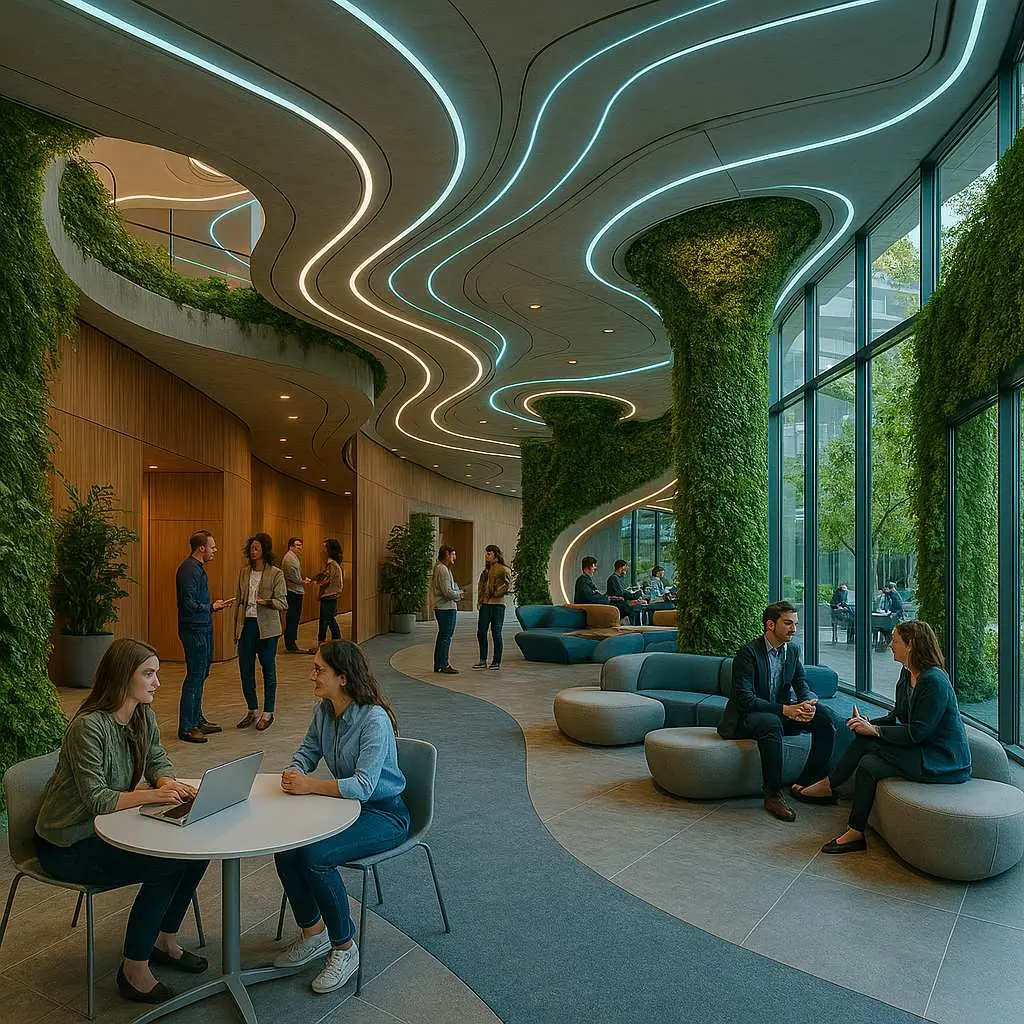
As we navigate increasingly complex social and technological landscapes, the need for spaces that foster genuine human connection feels more urgent than ever. The principles of spontaneous design and the cultivation of unscripted socials are not just niche architectural concepts; they are becoming central to creating resilient, adaptable, and human-centric environments.
We’re seeing a growing desire for authenticity and community, a pushback against sterile, overly controlled spaces. Trends like hybrid work models necessitate workplaces that are more than just rows of desks; they need to be hubs for collaboration, mentorship, and those organic interactions that are harder to replicate remotely. Mixed-use developments benefit immensely from transitional spaces and public realms that encourage casual mingling between residents, workers, and visitors.
Technology might also play a role, perhaps not by dictating interaction, but by subtly enhancing the environment. Think interactive surfaces that provide shared information, or responsive lighting and climate control that adapt to occupancy patterns, making communal spaces more comfortable and inviting when people are actually using them. However, the core remains human.
The future of architecture and design, I believe, lies in embracing this fluidity. It’s about creating frameworks – magical spaces – within which life can unfold in all its beautiful, unpredictable richness. It requires moving beyond purely aesthetic or efficiency-driven metrics to prioritize the quality of human experience. At Curvspace, we are committed to exploring and implementing dynamic social design strategies that nurture these vital unplanned encounters.
So, I invite you to think about the spaces you inhabit daily. Where do the moments of unexpected connection happen? Where could they happen? How could subtle changes in flow, seating, lighting, or the introduction of nature transform a sterile passage into a potential point of connection? What does your ideal ‘magical space’ for unscripted socials look and feel like? The potential for more connected, vibrant communities often lies hidden in plain sight, within the very design of our surroundings.
People Also Ask
What are unscripted socials?
Unscripted socials refer to spontaneous, unplanned interactions and conversations that occur naturally between people in shared spaces. Unlike scheduled meetings or events, they arise organically from chance encounters in places like hallways, lobbies, coffee stations, or communal areas.
How does architecture influence social interaction?
Architecture profoundly influences social interaction by shaping how people move through, perceive, and use spaces. Design elements like circulation paths, the visibility between areas, the placement and comfort of seating, the quality of lighting, and the nature of transitional spaces (like corridors and stairs) can either encourage or discourage informal encounters and conversations.
What is spontaneous design?
Spontaneous design is an approach to architecture and interior design that prioritizes creating environments conducive to unplanned activities and organic interactions, rather than rigidly programming every space. It focuses on flexibility, inviting transitional zones, biophilic elements, and subtle cues that allow users the agency to adapt spaces and engage in unscripted social encounters naturally.
Conclusion
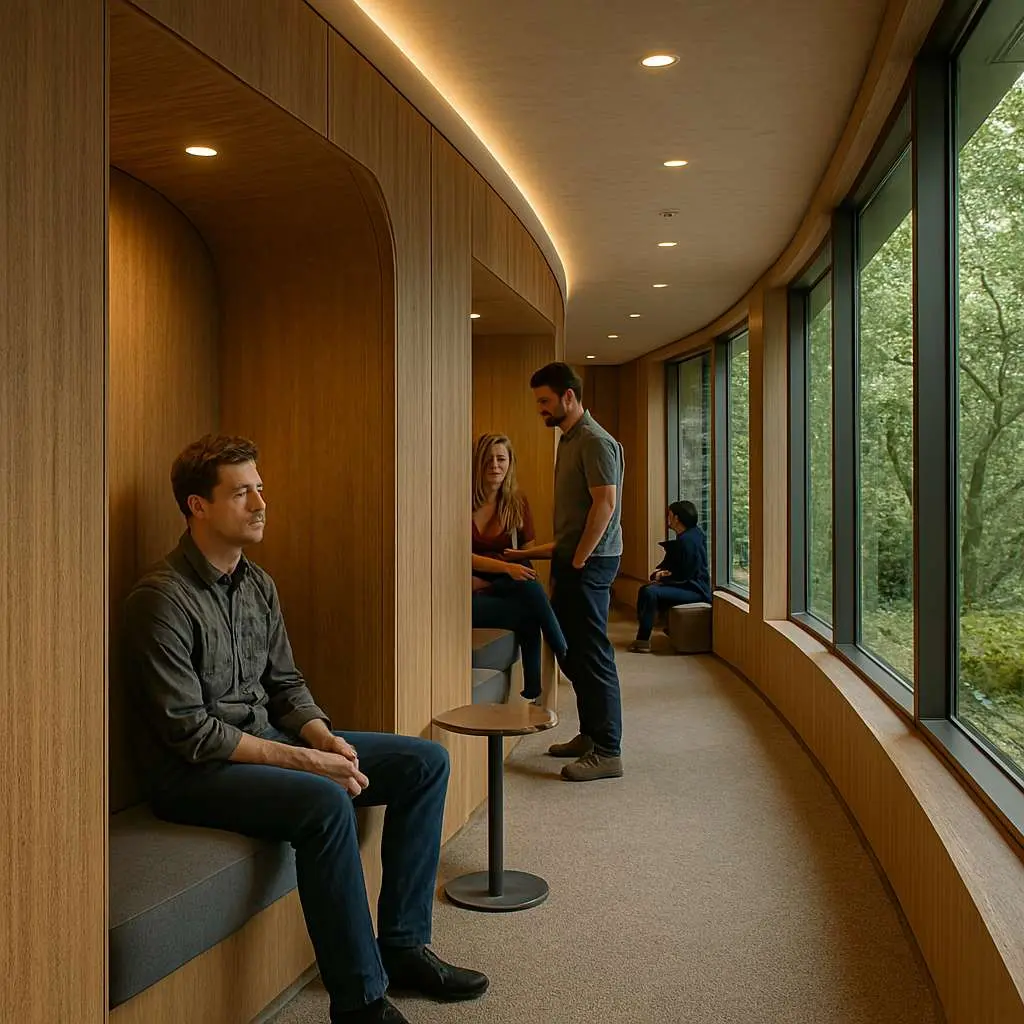
The subtle magic of unscripted socials enriches our lives, fostering community, sparking creativity, and weaving the vibrant tapestry of social connection. By embracing principles of spontaneous design, particularly in often-overlooked transitional spaces, we can create environments that don’t just accommodate life, but actively nurture these valuable organic interactions. At Curvspace, we design spaces where these serendipitous moments can flourish. Discover how our human-centric approach can transform your environment – contact Curvspace today.
References
- Alexander, Christopher. A Pattern Language: Towns, Buildings, Construction. Oxford University Press, 1977.
- Whyte, William H. The Social Life of Small Urban Spaces. Project for Public Spaces, 1980.
- Biophilic Design Principles: Kellert, Stephen R., Heerwagen, Judith H., and Mador, Martin L., eds. Biophilic Design: The Theory, Science and Practice of Bringing Buildings to Life. Wiley, 2008.
- Space Syntax Research: Hillier, Bill and Hanson, Julienne. The Social Logic of Space. Cambridge University Press, 1984.
Disclosure
Our content is reader-supported. This means if you click on some of our links, then we may earn a commission. Commissions do not affect our editor’s opinions or evaluations. Learn more about our editorial process.

About the Editorial Staff
The Curvspace editorial team comprises a diverse group of experts on intermediate and threshold spaces in homes and workplaces. Architects and interior designers, civil engineers and artists, environmental and behavioral psychologists, sociologists and anthropologists. All collaborate to create helpful content, that explores the full potential of these often-overlooked areas to enhance our daily lives.

